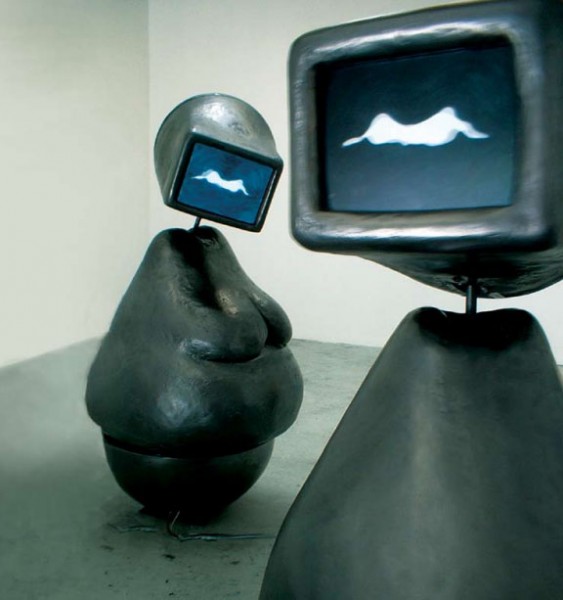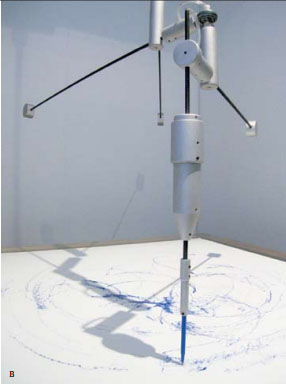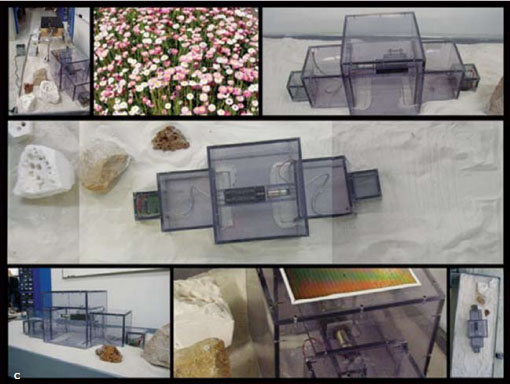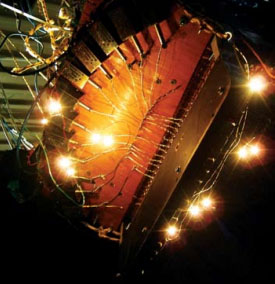By Robert Strauss
Today’s Machining Archives August 2007 Volume 03 Issue 08

Fernando Orellana’s father was a civil engineer and Fernando, when he was growing up, liked art. There seemed little to connect them.
“But I saw my father tinkering when he came home, doing this and that. I watched, but with no particular interest,” said Orellana. “Then someone connected the dots for me. What my dad was doing was no less art than what I did. The idea is that he was being creative and trying to figure things out. That is art.”
What finally dawned on Orellana is what has become an exciting mini-trend inmodern art, the connection of mechanics, technology and art, primarily sculpture. Since it is primarily robotics-based, it is called ArtBots, and its advocates are positively evangelical about it.

“The definition of robotics is not firm and, frankly, the definition of art isn’t firm either,” said Douglas Irving Repetto, whose day job is as the Director of Research at the Columbia University Computer Music Center, but whose lifeblood is as the guru of the ArtBot movement. He has been the curator of several significant ArtBot exhibitions, the most recent one this summer at the Klein Art Gallery in the University City Science Center, a research facility just off the campuses of the University of Pennsylvania and Drexel University. “It is a diverse and wide open field and full of open questions. The primary one is, ‘What does it mean for a non-human system to be creative?’ Each artist is asking different questions when he or she enters the world of robotics. There is a sense now that there is a lot here, and that we don’t really know the answers yet.”
Repetto curated the Klein Art Gallery exhibit, of which Orellana’s “Drawing Machine 2.1415926 v.2” was a part. Orellana, who is 33, has been tinkering, not unlike his civil engineer father, with the idea of a robot that can make its own art ever since he was an undergraduate at the Art Institute of Chicago.
“I enrolled with a painting and drawing focus, but by chance I took a couple of computer classes that related to art,” he said. The Art Institute of Chicago was at the forefront, he said, of the connection of technology to art. During his undergraduate years, Orellana produced what he called a “clunky” machine that he could program to make a small amount of randomly produced paintings. Then for his bachelor of fine arts show, he modified it so that certain sounds or movements around the machine would cause it to draw one way or another with its appendages, to which brushes were attached.
He heard about ArtBots in 2002 and got to show the drawing machine to Repetto. Soon, Orellana – almost now more like an agent for his robot than the artist himself – sold four of the drawing machine’s drawings through Sotheby’s ArtLink auction house, which emphasizes emerging modes of art from young artists. The Drawing Machine, under 10 years of age even then, was about as young an artist as there could be.
The Drawing Machine Orellana showed at the Philadelphia show was a more sophisticated version than that of his collegiate days. He is now a professor at Union College in Schenectady, New York, where for the last two years, he has been setting up a new electronic arts program in the computer science department. He is trying to get students to integrate all sorts of electronic and mechanical materials into their art.
He does just that with the Drawing Machine. As it sits ready to draw, the spectators can yell, hum, sing, whisper or otherwise create sounds that will affect the computerized system within the machine, changing its movements randomly.
“Once it does not hear anything interesting,” Orellana writes in his description of the piece, “it goes back to automatic drawing, slightly changing its programming by incorporating the data from the last sound it heard.” The drawings are usually a bit chaotic, not at all representational. So it isn’t a tree or a scene of bathers or a self-portrait with a damaged ear, but it is art, according to Orellana.

“Each piece it creates is different in that there is no way it can produce the same thing again. It isn’t a human being after all,” he said. “But they are also the same, like snowflakes. All are alike in that they are essentially the same shape, but different in the micro sense.” Artist Jason Van Anden grew up in an IBM-employeeinfested neighborhood in Yorktown Heights, outside of New York City.
“My parents weren’t IBMers, but there were so many around there that there was a computer lab in my middle school in 1977,” he said. He learned Basic by the time he was in grade school and even though he studied art, “I hung out with bigger computer nerds than I was, so it was natural to incorporate it in my art.”
Now, Van Anden said, he lives in what might be the first ArtBot community in the country, near Prospect Park in Brooklyn.
“There is a ragtag group of us here,” he said. “It’s the do-it-yourself crowd.” Van Anden’s signature ArtBot piece is Neil and Iona, two robots in the quasi-R2D2 mode that interact with people viewing them, and with each other. To Van Anden, they are the first step in finding out whether robots can have feelings.
 Neil and Iona are about life-sized, though with television-like heads and pear-shaped bodies on a swivel at the base.
Neil and Iona are about life-sized, though with television-like heads and pear-shaped bodies on a swivel at the base.
“They have a magical kind of feel to them,” said Dan Schimmel, the curator of the Klein Gallery in Philadelphia, where Neil and Iona took up residence during that Gallery’s ArtBot spring show. “They were definitely engaged with each other. They made sounds like the underwater noises during the mating rituals of whales. It was definitely more mysterious than grunting. It was definitely a happy kind of thing.”
Van Anden developed a software system that allows Neil and Iona to act out improvisational phases. There is a Mac Mini in each head with the monitor and an Ethernet connection in the neck that helps control the motion sensors inside each sculpture.
Neil and Iona have animated facial expressions that change when people – or the other sculpture – passes by cameras underneath their chins.
“When they see someone, it changes the weight for the computer system. It causes a radical shift in the behavior [of the sculpture],” Van Anden said. “Each time the robots interact, they pass information between each other and weigh the probability toward the other one.
In other words, if one is ‘happy,’ it will get sadder as the other one gets happier, until they reach parity.”
With all this going on, Neil and Iona appear, with gallery-goers around them, to be living creatures, according to Van Anden, “living puppets capable of pulling their own strings.”
The Klein Gallery show also had a young student component. Schimmel discovered that schools in both the city and suburbs of Philadelphia were interested in enhancing their technology programs with an artistic component. One school had a robot that worked underwater. It floated around a 100-gallon tub and with its underwater camera, visitors could see what it was looking at through a monitor attached above the surface.
“Another had a robot that you could fasten a brush to, with a remote control like with toy cars,” said Schimmel. “It was engineered to dip into different colors of paint and then swivel around to paint a picture. It was crude, but it was art.
“ArtBots, in this way, can excite kids not only about art, but about the practical applications of robotics and engineering,” he said. “What seems like diametrically opposed things are actually quite complementary.”
Van Anden and Orellana are already on to their next projects. Orellana is looking for ways to anthropomorphize inanimate objects. For a show in Saratoga Springs, New York, he embedded four robots in the ceiling of an elevator. Each time a person got in the elevator, the robots became curious, and that caused the dynamics of the elevator, and the people in it, to change. He embedded a couch with a robot in a living room in another piece.
“Pun intended, the room then became living – alive. I wanted to see what it would be like if a couch was sentient,” he said.
For Van Anden, his own future work may not look exactly robotic, but it will definitely be of the ArtBot genre. “It is about the motion and the gesture, that is what ArtBots is about,” he said. “As a film is to a painting, a robot– an ArtBot – is to a painting.”
